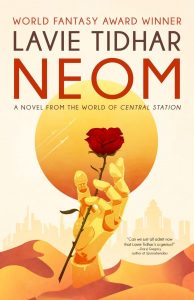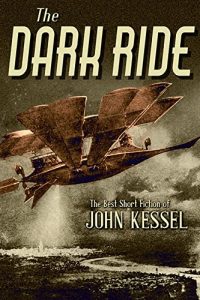Gary K. Wolfe Reviews Neom by Lavie Tidhar
 Neom, Lavie Tidhar (Tachyon 978-1-61696-382-8, $17.95, 240pp, tp) November 2022.
Neom, Lavie Tidhar (Tachyon 978-1-61696-382-8, $17.95, 240pp, tp) November 2022.
Every so often, arguments erupt on social media about whether it’s even worthwhile to read old-school ‘‘golden age’’ SF, given the vast cultural and demographic broadening of the field during the past few decades. It’s always struck me as an unnecessary dichotomy, since no two writers have the same set of ancestors anyway, and since it’s entirely possible to recognize the old while celebrating the new. A case in point is Lavie Tidhar, who has certainly promoted newer voices with his Apex World Science Fiction series of anthologies, and whose own fiction has been as adventurous and occasionally transgressive as anyone’s – but who clearly appreciates many of his more traditional forebears. His most direct engagement with classic SF themes was the series of stories knitted together in Central Station (2016), with its diverse cast of characters who live and work around a massive spaceport called Central Station in a future Tel Aviv, and whose stories gradually intersect. Tidhar returns to that world in Neom, but the setting has shifted to a huge, built-from-scratch metropolis on the eastern shore of the Red Sea, which is already ancient as the story opens. (As Tidhar tells us in a headnote, the city Neom is already under construction by Saudi Arabia, and a quick Google search of images reveals a whole passel of SF illustrations that don’t know they’re SF illustrations.)
As with Central Station, we’re introduced to a diverse group whose stories weave in and out of each other: Mariam de la Cruz, who lives in the poorer Nineveh Quarter of Neom and makes ends meet with a variety of jobs; her former childhood friend Nasir, a cop; Saleh, an orphan who joins a trading caravan, hoping to eventually make his way to Mars; Mukhtan, a trader in obsolete tech (he’s thrilled to have found an old Atari cartridge with Pac-Man); Sharif, a brilliant mechanic skilled in reviving ancient machines; Nasu, a centuries-old former ‘‘terrorartist’’; a talkative jackal, and a philosophical robot. While the first several chapters explore the setting and introduce the main characters – sometimes through lovely vignettes such as Mariam giving a single rose to the robot – the plot really begins to get underway after Saleh discovers a huge crashed spaceship in a desert already littered with dangerous mecha from earlier wars (much as in Cat Sparks’s Lotus Blue), and after the robot, for reasons not immediately clear, digs up the dismembered remains of a strange golden man. The mystery of the golden man eventually draws most of the characters together, as well as catching the attention of the ominous and still very dangerous Nasu.
At times Tidhar’s narrative takes on a gentle, ruminative air, and while that helps establish the atmosphere of a convincing, lived-in city, veteran SF readers will also find plenty of playful and affectionate Easter eggs. The various models of robots draw their names from Simak, Dick, and Bester (one of the ‘‘Fondlies’’ even gets overheated and goes on a killing spree); Asimov’s First Law of Robotics gets cited by that chatty, philosophical robot; hermit-like settlers are called Websters (as in Simak’s City); space is called the Up and Out (à la Cordwainer Smith); a cigarette brand is Ubiq; an ancient bioweapon is named Shambleau (from C.L. Moore, though we already met these in Central Station); there are even nods to a toaster on Mars (Disch) and four-armed Martian warriors (Burroughs, although they also show up in Tidhar’s Martian Sands). There are also sandworms, because why not? There’s still more, but it may be a tribute to Tidhar’s clear and engaging narrative voice that readers who notice none of these allusions won’t feel they’re missing anything. Nor is it necessary to have read Central Station, although it does help flesh out Tidhar’s emerging portrait of a transformed Middle East. For all its fearsome ancient ordnance, its economic disparity, and its looming threats, Neom easily joins the list of SF cities we’d like to visit.
Gary K. Wolfe is Emeritus Professor of Humanities at Roosevelt University and a reviewer for Locus magazine since 1991. His reviews have been collected in Soundings (BSFA Award 2006; Hugo nominee), Bearings (Hugo nominee 2011), and Sightings (2011), and his Evaporating Genres: Essays on Fantastic Literature (Wesleyan) received the Locus Award in 2012. Earlier books include The Known and the Unknown: The Iconography of Science Fiction (Eaton Award, 1981), Harlan Ellison: The Edge of Forever (with Ellen Weil, 2002), and David Lindsay (1982). For the Library of America, he edited American Science Fiction: Nine Classic Novels of the 1950s in 2012, with a similar set for the 1960s forthcoming. He has received the Pilgrim Award from the Science Fiction Research Association, the Distinguished Scholarship Award from the International Association for the Fantastic in the Arts, and a Special World Fantasy Award for criticism. His 24-lecture series How Great Science Fiction Works appeared from The Great Courses in 2016. He has received six Hugo nominations, two for his reviews collections and four for The Coode Street Podcast, which he has co-hosted with Jonathan Strahan for more than 300 episodes. He lives in Chicago.
This review and more like it in the Sepetmber 2022 issue of Locus.
 While you are here, please take a moment to support Locus with a one-time or recurring donation. We rely on reader donations to keep the magazine and site going, and would like to keep the site paywall free, but WE NEED YOUR FINANCIAL SUPPORT to continue quality coverage of the science fiction and fantasy field.
While you are here, please take a moment to support Locus with a one-time or recurring donation. We rely on reader donations to keep the magazine and site going, and would like to keep the site paywall free, but WE NEED YOUR FINANCIAL SUPPORT to continue quality coverage of the science fiction and fantasy field.
©Locus Magazine. Copyrighted material may not be republished without permission of LSFF.







